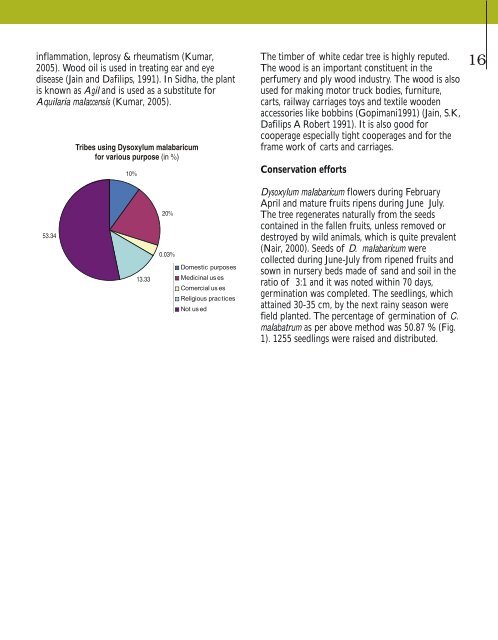Images - IUCN
Images - IUCN
Images - IUCN
Create successful ePaper yourself
Turn your PDF publications into a flip-book with our unique Google optimized e-Paper software.
inflammation, leprosy & rheumatism (Kumar,<br />
2005). Wood oil is used in treating ear and eye<br />
disease (Jain an d Dafilips, 1991). In Sidha, the plant<br />
is known as Agil and is used as a substitute for<br />
Aquilaria malaccensis (Kumar, 2005).<br />
Number of individuals using Dysoxylum<br />
malabaricum for various purposes<br />
Number of individuals using Dysoxylum<br />
20%<br />
malabaricum for various purposes<br />
16<br />
53.34<br />
16<br />
Tribes using Dysoxylum malabaricum<br />
for various purpose (in %)<br />
3<br />
4<br />
6<br />
1<br />
3<br />
10%<br />
4<br />
13.33<br />
6<br />
1<br />
0.03%<br />
Domestic purposes<br />
Medicinal us es<br />
Comercial us es<br />
Religious practices<br />
Not us ed<br />
The timber of white cedar tree is highly reputed.<br />
The wood is an important constituent in the<br />
perfumery and ply wood industry. The wood is also<br />
used for making motor truck bodies, furniture,<br />
carts, railway carriages toys and textile wooden<br />
accessories like bobbins (Gopimani1991) (Jain, S.K,<br />
Dafilips A Robert 1991). It is also good for<br />
cooperage especially tight cooperages and for the<br />
frame work of carts and carriages.<br />
Conservation efforts<br />
Dysoxylum<br />
Domestic<br />
malabaricum<br />
purposes<br />
flowers during February<br />
April and mature fruits ripens during June July.<br />
The Medicinal tree regenerates uses naturally from the seeds<br />
contained<br />
Comercial<br />
in<br />
us<br />
the<br />
es<br />
fallen fruits, unless removed or<br />
destroyed by wild animals, which is quite prevalent<br />
(Nair, Religious 2000). practices Seeds of D. malabaricum were<br />
collected<br />
Not us ed<br />
during June-July from ripened fruits and<br />
sown in nursery beds made of sand and soil in the<br />
ratio of 3:1 and it was noted within 70 days,<br />
germination was completed. The seedlings, which<br />
attained 30-35 cm, by the next rainy season were<br />
field planted. The percentage of germination of C.<br />
malabatrum as per above method was 50.87 % (Fig.<br />
1). 1255 seedlings were raised and distributed.<br />
16

















